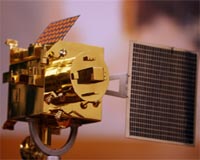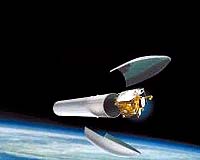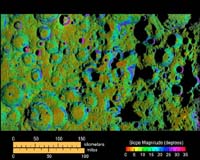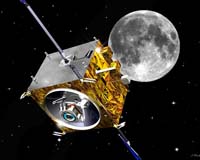| October 23, 2008 |  |
SpaceDaily Advertising Kit |
|
India eyes larger slice of satellite launch sector New Delhi (AFP) Oct 23, 2008  India's first moon mission not only makes it a serious player in space exploration but also holds the prospect of a bigger slice of the lucrative satellite launch market, analysts say. The country staged a flawless launch Wednesday of its first unmanned lunar orbiting spacecraft Chandrayaan-1 - the Sanskrit word for Moon Craft - with an Indian-built rocket from its southeastern coast. ... read more
India's first moon mission not only makes it a serious player in space exploration but also holds the prospect of a bigger slice of the lucrative satellite launch market, analysts say. The country staged a flawless launch Wednesday of its first unmanned lunar orbiting spacecraft Chandrayaan-1 - the Sanskrit word for Moon Craft - with an Indian-built rocket from its southeastern coast. ... read moreIndia launches first moon mission  Sriharikota, India (AFP) Oct 22, 2008
Sriharikota, India (AFP) Oct 22, 2008India successfully launched its first lunar mission Wednesday, marking a major boost for the country's space programme and a new step in the fast-developing Asian space race. Cheers rang out at mission control as the unmanned lunar orbiting spacecraft Chandrayaan-1 was launched with an Indian-built rocket from the Satish Dhawan Space Centre in Sriharikota on the southeastern coast. ... more |
China's Shenzhou-19 astronauts return to Earth: state media
CORRECTED: China's Shenzhou-19 astronauts return to Earth: state media Thawing permafrost dots Siberia with rash of mounds UK 'not ready' for effects of climate change, experts warn How climate change turned Sao Paulo's drizzle into a storm Finland says supports EU goal to cut emissions 90 percent by 2040 US climate assessment in doubt as Trump dismisses authors CORRECTED: How can an electricity network go down in five seconds? How can an electricity network go down in five seconds? France, Germany and Italy failing to stop destructive fishing: NGOs
|
|
| Previous Issues | Oct 22 | Oct 21 | Oct 20 | Oct 18 | Oct 17 |
Chandrayaan-2 Likely Next Year End Or 2010 Sriharikota, India (PTI) Oct 23, 2008
Sriharikota, India (PTI) Oct 23, 2008After the successful launch of India's first unmanned mission to moon, Chandrayaan-1, the Indian Space Research Organisation (ISRO) is planning to send its second lunar odyssey, Chandrayaan-2, an Indo-Russian joint venture, likely by the end of next year or early 2010. The work on this project would be taken up after Chandrayaan-1 starts its task of researching the moon, ISRO Chairman ... more Second Chinese-Brazilian Satellite Fulfils 5-Year Mission In Orbit  Rio De Janeiro, Brazil (XNA) Oct 23, 2008
Rio De Janeiro, Brazil (XNA) Oct 23, 2008The second earth resource satellite, CBERS-2, developed jointly by Brazil and China, fulfilled its five years' mission in orbit on Tuesday, the National Institute of Space Investigations of Brazil (INEP) said. The CBERS-2 was launched on Oct. 21, 2003 by the Chinese Long March 4B rocket from Taiyuan launch facilities in China. Sample images from CBERS-2 were made available on Jan. 10, 2007 ... more The Oddball Hosts Of Gamma-Ray Bursts  Huntsville AL (SPX) Oct 23, 2008
Huntsville AL (SPX) Oct 23, 2008There's a universal tendency to heed Dylan Thomas's exhortation and go out with a bang instead of a whimper. Nowhere is this more evident than deep in the cosmos. When their time is up, stars make their exits in a number of flamboyant ways. The most massive stars leave with the greatest fanfare of all - blasting out gamma-ray bursts (GRBs), tremendous explosions that rock the Universe like ... more |
launchers:
 industry:  spacetravel:  |
Phoenix Lander Finishes Soil Delivery To Onboard Labs Pasadena CA (SPX) Oct 23, 2008
Pasadena CA (SPX) Oct 23, 2008NASA's Phoenix Mars Lander has finished scooping soil samples to deliver to its onboard laboratories, and is now preparing to analyze samples already obtained. Scientists are anxious to analyze the samples as the power Phoenix generates continues to drop. The amount of sunlight is waning on Mars' northern plains as late-summer turns to fall. The spacecraft's robotic arm is digging into the ... more Telescope Sees Pulsar That Winks Back With Gamma-Ray Beams  Stanford CA (SPX) Oct 23, 2008
Stanford CA (SPX) Oct 23, 2008About three times a second, the rotating corpse of a 10,000-year-old star sweeps a beam of gamma rays toward Earth. This object, known as a pulsar, is the first one known to "blink" at Earth only in gamma rays, and was discovered by an orbiting observatory launched in June with significant involvement from researchers at Stanford and the SLAC National Accelerator Laboratory. "This is the ... more Sarantel Antenna Featured In New Iridium 9555 Satellite Phone  Bethesda MD (SPX) Oct 23, 2008
Bethesda MD (SPX) Oct 23, 2008Iridium Satellite and Sarantel announce that the Sarantel PowerHelix antenna technology was selected for, and is being built into, the just-released Iridium 9555 handset. Sarantel develops and manufactures some of the world's most advanced miniature filtering antennas for mobile, wireless and handheld devices. Iridium is a pioneer in the satellite communications industry and is the only ... more The Case Of The Missing Gamma-Ray Bursts  Huntsville AL (SPX) Oct 23, 2008
Huntsville AL (SPX) Oct 23, 2008Gamma-ray bursts are by far the brightest and most powerful explosions in the Universe, second only to the Big Bang itself. So it might seem a bit surprising that a group of them has gone missing. A single gamma-ray burst (GRB) can easily outshine an entire galaxy containing hundreds of billions of stars. Powerful telescopes can see them from clear across the Universe. And because the deep ... more |
iss:
 lunar:  lunar:  |
| Previous Issues | Oct 22 | Oct 21 | Oct 20 | Oct 18 | Oct 17 |
| The contents herein, unless otherwise known to be public domain, are Copyright 1995-2008 - SpaceDaily. AFP and UPI Wire Stories are copyright Agence France-Presse and United Press International. ESA Portal Reports are copyright European Space Agency. All NASA sourced material is public domain. Additional copyrights may apply in whole or part to other bona fide parties. Advertising does not imply endorsement, agreement or approval of any opinions, statements or information provided by SpaceDaily on any web page published or hosted by SpaceDaily. Privacy statement |